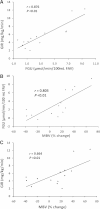Early microvascular recruitment modulates subsequent insulin-mediated skeletal muscle glucose metabolism during lipid infusion
- PMID: 22961574
- PMCID: PMC3526221
- DOI: 10.2337/dc11-2399
Early microvascular recruitment modulates subsequent insulin-mediated skeletal muscle glucose metabolism during lipid infusion
Abstract
Objective: To test whether early, insulin-mediated microvascular recruitment in skeletal muscle predicts steady-state glucose metabolism in the setting of physiological elevation of free fatty acid concentrations.
Research design and methods: We measured insulin's microvascular and metabolic effects in 14 healthy young adults during a 2-h euglycemic insulin clamp. Plasma free fatty acid concentrations were raised (Intralipid and heparin infusion) for 3 h before the clamp and maintained at postprandial concentrations during the clamp. Microvascular blood volume (MBV) was measured by contrast-enhanced ultrasound (CEU) continuously from baseline through the first 30 min of the insulin clamp. Muscle glucose and insulin uptake were measured by the forearm balance method.
Results: The glucose infusion rate (GIR) necessary to maintain euglycemia during the clamp varied by fivefold across subjects (2.5-12.5 mg/min/kg). The early MBV responses to insulin, as indicated by CEU video intensity, ranged widely, from a 39% decline to a 69% increase. During the clamp, steady state forearm muscle glucose uptake and GIR each correlated significantly with the change in forearm MBV (P < 0.01). To explore the basis for the wide range of vascular and metabolic insulin sensitivity observed, we also measured V(O(2max)) in a subset of eight subjects. Fitness (V(O(2max))) correlated significantly with the GIR, the forearm glucose uptake, and the percentage change in MBV during the insulin clamp (P < 0.05 for each).
Conclusions: Early microvascular responses to insulin strongly associate with steady state skeletal muscle insulin-mediated glucose uptake. Physical fitness predicts both metabolic and vascular insulin responsiveness.
Figures



Similar articles
-
Physiologic hyperinsulinemia enhances human skeletal muscle perfusion by capillary recruitment.Diabetes. 2001 Dec;50(12):2682-90. doi: 10.2337/diabetes.50.12.2682. Diabetes. 2001. PMID: 11723050
-
Muscle microvascular recruitment predicts insulin sensitivity in middle-aged patients with type 1 diabetes mellitus.Diabetologia. 2012 Mar;55(3):729-36. doi: 10.1007/s00125-011-2402-3. Epub 2011 Dec 14. Diabetologia. 2012. PMID: 22167126 Free PMC article. Clinical Trial.
-
Muscle contraction, but not insulin, increases microvascular blood volume in the presence of free fatty acid-induced insulin resistance.Diabetes. 2009 Nov;58(11):2457-63. doi: 10.2337/db08-1077. Epub 2009 Aug 12. Diabetes. 2009. PMID: 19675134 Free PMC article.
-
Lipid infusion impairs physiologic insulin-mediated capillary recruitment and muscle glucose uptake in vivo.Diabetes. 2002 Apr;51(4):1138-45. doi: 10.2337/diabetes.51.4.1138. Diabetes. 2002. PMID: 11916937
-
Insulin-induced microvascular recruitment in skin and muscle are related and both are associated with whole-body glucose uptake.Microcirculation. 2012 Aug;19(6):494-500. doi: 10.1111/j.1549-8719.2012.00174.x. Microcirculation. 2012. PMID: 22360160 Clinical Trial.
Cited by
-
Hyperinsulinemia blunts sympathetic vasoconstriction: a possible role of β-adrenergic activation.Am J Physiol Regul Integr Comp Physiol. 2021 Jun 1;320(6):R771-R779. doi: 10.1152/ajpregu.00018.2021. Epub 2021 Apr 14. Am J Physiol Regul Integr Comp Physiol. 2021. PMID: 33851554 Free PMC article.
-
Metabolic and vascular insulin resistance: partners in the pathogenesis of cardiovascular disease in diabetes.Am J Physiol Heart Circ Physiol. 2025 Jun 1;328(6):H1218-H1236. doi: 10.1152/ajpheart.00826.2024. Epub 2025 Apr 21. Am J Physiol Heart Circ Physiol. 2025. PMID: 40257392 Free PMC article. Review.
-
Sympathetically mediated increases in cardiac output, not restraint of peripheral vasodilation, contribute to blood pressure maintenance during hyperinsulinemia.Am J Physiol Heart Circ Physiol. 2020 Jul 1;319(1):H162-H170. doi: 10.1152/ajpheart.00250.2020. Epub 2020 Jun 5. Am J Physiol Heart Circ Physiol. 2020. PMID: 32502373 Free PMC article.
-
Diabetic Microvascular Disease: An Endocrine Society Scientific Statement.J Clin Endocrinol Metab. 2017 Dec 1;102(12):4343-4410. doi: 10.1210/jc.2017-01922. J Clin Endocrinol Metab. 2017. PMID: 29126250 Free PMC article. Review.
-
Insulin-mediated muscle microvascular perfusion and its phenotypic predictors in humans.Sci Rep. 2021 Jun 1;11(1):11433. doi: 10.1038/s41598-021-90935-8. Sci Rep. 2021. PMID: 34075130 Free PMC article. Clinical Trial.
References
-
- Vincent MA, Clerk LH, Lindner JR, et al. Microvascular recruitment is an early insulin effect that regulates skeletal muscle glucose uptake in vivo. Diabetes 2004;53:1418–1423 - PubMed
-
- Eggleston EM, Jahn LA, Barrett EJ. Hyperinsulinemia rapidly increases human muscle microvascular perfusion but fails to increase muscle insulin clearance: evidence that a saturable process mediates muscle insulin uptake. Diabetes 2007;56:2958–2963 - PubMed
-
- Coggins MP, Lindner J, Rattigan S, et al. Physiologic hyperinsulinemia enhances human skeletal muscle perfusion by capillary recruitment. Diabetes 2001;50:2682–2690 - PubMed
-
- Zhang L, Vincent MA, Richards SM, et al. Insulin sensitivity of muscle capillary recruitment in vivo. Diabetes 2004;53:447–453 - PubMed
-
- Yki-Järvinen H, Utriainen T. Insulin-induced vasodilatation: physiology or pharmacology? Diabetologia 1998;41:369–379 - PubMed

